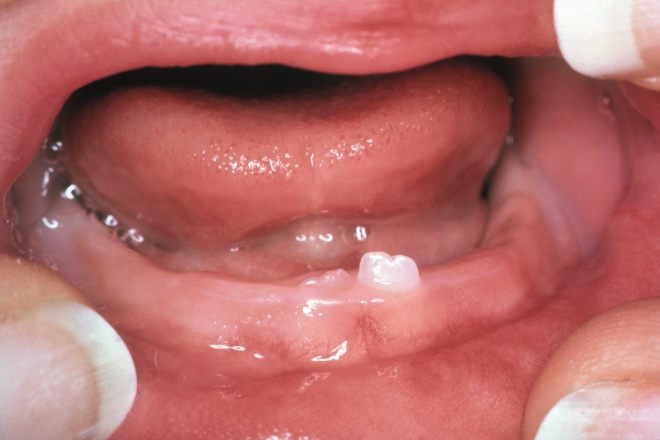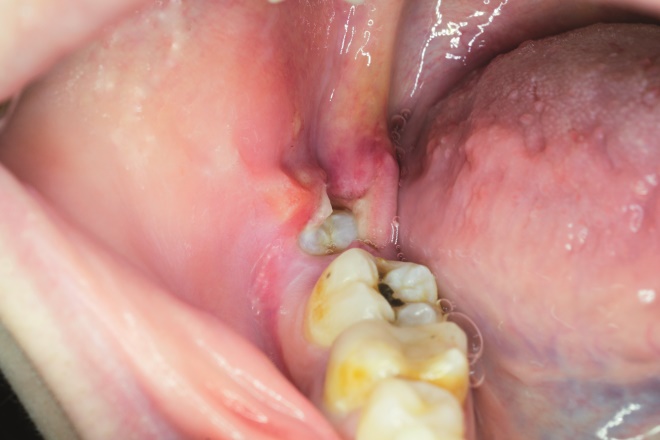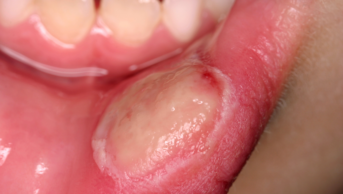
Science Photo Library
There is variability in the consistency of advice for patients with a dental emergency, especially outside of their dentist’s opening hours. With an estimated 25% of five-year-olds experiencing dental decay[1]
and an increasingly ageing population[2]
, it is important that patients can easily access appropriate care.
Oral diseases can limit patients’ ability to perform normal day-to-day tasks (e.g. sleeping and going to work), and can lead to avoidance of social situations and low self-esteem.
Patients’ symptoms may be as a result of poor general oral health or adverse effects from medicines, such as dry mouth[3]
. These factors increase risk of tooth loss from dental decay or gum disease.
In this article — the first of three on dental emergencies — six soft tissue conditions will be discussed. The assessment and management of hard tissue dental emergencies will be reviewed in the next part of this series.
Oral ulceration

Source: Science Photo Library
Mouth ulcers are common and should clear up on their own within a week or two
Soft tissue trauma is a common cause of oral ulceration, which includes physical trauma (e.g. a sharp tooth or orthodontic brace) and thermal trauma (e.g. a burn to the mouth with a hot drink). Chemical burns resulting in oral ulceration are also possible, for example holding an aspirin tablet inside the mouth (owing to the misconception that this will help a sore tooth), as well as other causes, such as haematological discrepancies and gastroÂintestinal disorders. Drug-induced oral ulceration (e.g. with nicorandil) is a further cause[4]
; however, in this instance, the patient’s medicine should not be stopped without consultation with their doctor.
In addition, ulcers may be as a result of a viral infection; these patients can be unwell with a fever and may require further assessment by a doctor.
Diagnosis
Questions to ask the patient:
- How long has the ulcer been present?
- Have you damaged the skin or the gum?
- Is there a broken or sharp tooth, or an appliance such as a brace or denture?
- Do you have anaemia, gastrointestinal symptoms or skin conditions?
- Do you take any medicines?
Advice
Topical analgesia and anaesthetic gels can be recommended to patients. Benzydamine hydrochloride is suitable for use in non-asthmatic patients if multiple ulcers are present or if they are difficult to access, while chlorhexidine mouthwash may reduce the risk of superinfection of the ulcer.
Advise patients to remove ill-fitting or brand-new dentures until dental advice is sought because adjustments may be needed[5]
.
Urgent care should be sought if the ulcer has been present for three weeks or longer, due to the ulcer potentially being malignant, or if there are signs of severe dehydration[5],[6]
.
Ulcers can be caused by trauma to anaesthetised soft tissues following recent dental treatment, for example by biting a numb lip. Advise the patient to avoid further trauma, hot drinks and smoking until normal sensation returns.
Teething

Source: Science Photo Library
Baby teeth sometimes emerge with no pain, while other times they can cause difficulties in sleeping and eating. Most babies start teething at around six months of age
Primary teeth begin to appear at around six months of age and secondary teeth around six years of age. The British Society of Paediatric Dentistry advises that children are taken to see a dentist as soon as the first teeth erupt and before the child’s first birthday[7]
.
Diagnosis
Questions to ask the parent or carer:
- What is the age of the child?
- Can you see a tooth erupting or feel it with your finger?
- Is the child eating and taking fluids?
- Does the child have a fever?
Advice
Teething can cause difficulties in sleeping and eating. Paracetamol or ibuprofen oral suspension may help discomfort and pyrexia. Lidocaine topical gel is useful if the area causing discomfort can be easily reached. Soft and pureed foods can also be helpful.
Good oral hygiene and tooth brushing should also be advised (see ‘Role of the pharmacist’). All children with pyrexia should be assessed by a healthcare professional owing to the risk of serious illness[6]
.
Pericoronitis

Source: Science Photo Library
Wisdom teeth (third molars) usually start to erupt during late adolescence.
Pericoronitis describes inflammation of the gum tissues around an erupting tooth, which usually occurs in the lower jaw. Patients generally complain of swelling of the gums, discomfort on mouth opening and pain that is localised around a tooth that is partially erupting.
Diagnosis
Questions to ask the patient:
- Is there swelling in the wisdom tooth region?
- Is there a bad taste in your mouth?
- Do you have difficulty opening your mouth?
- How are you managing the pain?
Advice
Analgesia, such as ibuprofen or paracetamol, can be recommended. Rinsing with 0.2% chlorhexidine mouthwash or warm salty water, particularly after meals, will help to keep the area clean.
Patients may be prescribed a short course of antibiotics, such as metronidazole. This is only indicated when the patient shows signs of spreading infection, such as a fever or facial swelling, or if they are immunocompromised[5],[6]
.
If the patient has limited mouth opening or they are struggling to swallow, they should be referred for urgent medical or dental help.
Bleeding after a tooth extraction

Source: Alamy Stock Photo
Bleeding after a tooth extraction should stop soon after surgery, but patients may find it starts again if they knock the blood clot that forms over the socket
A patient who has had a tooth extraction on a Friday afternoon may find that the bleeding returns outside of their dentist’s opening hours. The pharmacist should take the patient into a private area or consultation room before checking the details of the treatment, the methods attempted to control the bleeding and their medical history. Patients should also be reassured that blood-stained saliva is normal following a tooth extraction.
Diagnosis
Questions to ask the patient:
- When was the tooth removed?
- Is there blood-stained saliva or a constant flow of blood from the extraction site?
- How long has the bleeding been occurring?
- Are you taking any anticoagulant medicine?
- Do you have a haematological condition (e.g. haemophilia)?
Advice
Patients taking warfarin should have their international normalised ratio (INR) checked no more than 72 hours prior to a tooth extraction. Those with INR readings of less than four should generally being managed by dentists in primary care. New oral anticoagulant drugs do not require monitoring for dental extractions and patients should not be advised to stop taking their medicines without prior consultation with a healthcare professional[8]
.
Take the following steps if active bleeding is present[6]
:
- Sit the patient upright;
- Advise the patient to place a clean, rolled up cotton handkerchief or gauze directly over the extraction socket;
- Ask the patient to bite down firmly for 20 minutes — if there is no opposing tooth to bite onto, use firm finger pressure;
- After 20 minutes, remove the pressure and check if the bleeding has stopped.
Ask another member of the team to record the time to ensure pressure has been applied for a full 20 minutes. This will also serve as useful information to other healthcare professionals if further medical assessment is required. If the bleeding does not stop after following these steps, refer the patient to a dentist or call NHS 111.
If the bleeding stops, the following aftercare instructions should be provided to the patient both verbally and in writing:
- No spitting or rinsing the mouth for 24 hours;
- No vigorous exercise or hot drinks/food for 24 hours;
- No smoking or alcohol;
- Brush the teeth but do not place the toothbrush in the extraction site;
- After 24 hours, rinse with warm salty water;
- Follow previous instructions described and visit the dentist if bleeding starts again;
- Attend A&E urgently if uncontrolled bleeding occurs out of dentist opening hours.
Facial swelling

Source: Alamy Stock Photo
If the patient is unable to swallow their saliva or push their tongue out of their mouth, call 999
Facial swelling can be considered a true dental emergency because head and neck infections can progress rapidly and may be life threatening, especially if the patient is immunocompromised. In all cases of facial swelling or suspected dental abscess, there should be a low threshold to seek advice from other healthcare professionals. Contact a dentist, the local maxillofacial hospital department or NHS 111 to confirm the management of the patient.
Diagnosis
To assess the patient, first check if their airway is compromised by checking if the patient is able to:
- Swallow their own saliva;
- Push their tongue forward out of the mouth.
If either of these are impaired, refer immediately for emergency care or call 999[5]
. In particular, a ‘hot-potato voice’ (where the patient’s speech resembles that of someone with a hot potato in their mouth) is a classic sign of Ludwig’s angina, which also involves a potentially fatal, severe swelling of the floor of the mouth that requires emergency care[9]
.
Questions to ask the patient:
- Is the swelling sudden and unexplained?
- Has the swelling worsened in the past hour?
- Is the swelling closing the eye?
- Is there a history of rigors, increasing temperature, dehydration or lethargy?
Advice
Ibuprofen or paracetamol may be appropriate analgesia and antibiotics may be required in the interim before the patient seeks dental management[5],[6]
. Sudden and unexplained swelling could indicate anaphylaxis or angioedema. If any of these are reported, emergency care should be sought by referring the patient to A&E or calling 999.
Bleeding swollen gums

Source: Science Photo Library
Red and swollen gums, or gums that bleed after brushing, can be an indication that the patient has gum disease
Bleeding, swollen gums can indicate gum disease, where the main aetiological factor is poor oral hygiene. Associated signs include wobbly teeth and bad breath[10]
. Pregnancy and diabetes are risk factors for gum problems that can exacerbate bleeding[6]
, as well as smoking in the progression of the condition. Patients who have recently stopped smoking may experience a temporary increase in bleeding gums resulting from changes in tissue perfusion.
Diagnosis
Questions to ask the patient:
- How often do you brush your teeth?
- Do you use interdental cleaning aids?
- Do you notice blood when you spit after brushing?
- Have you noticed wobbly teeth or bad breath?
Discussing the patient’s oral hygiene regimen will highlight areas of poor compliance. Patients can also expect an increase in their symptoms when they initially start to improve their toothbrushing routine.
Advice
Patients should brush their teeth twice daily for two minutes, including the gum line, and also use interdental cleaning aids. Furthermore, they should rinse with chlorhexidine mouthwash at a different time to brushing. Smoking cessation will help with reducing symptoms and patients should be signposted to relevant services[11]
.
Patients with the following symptoms require urgent dental assessment as alternative aetiologies may be implicated, such as viral infections[6]
:
- High temperature;
- Nausea;
- Vomiting;
- Oral ulceration.
The conditions and management options covered should not be viewed as an exhaustive list. Further information should be sought from relevant professional guidance.
Role of the pharmacist
Patients should be encouraged to attend routine dental check-ups and to brush their teeth twice daily. Children, pregnant women and new mothers are eligible for free NHS dental treatment.
Pharmacists can also advise patients of lifestyle factors that can reduce their chance of developing tooth decay, such as reducing the amount of sugary and starchy food and drinks consumed, as well as smoking cessation and reducing alcohol consumption.
However, pharmacists should consider if the presenting problem is within their scope of practice. If not, urgent care advice can be sought through NHS 111, while emergency services should be contacted in a life-threatening emergency. Pharmacists and their teams should be aware of the local NHS dental practices where they can signpost patients.
Local dental practices and hospital maxillofacial departments are valuable sources for pharmacists to obtain a second opinion if there is uncertainty regarding the management options of a condition. For example, for a patient taking warfarin with uncontrolled bleeding following a dental extraction.
References
[1] Public Health England. Child oral health: applying all our health. 2018. Available at: https://www.gov.uk/government/publications/child-oral-health-applying-all-our-health (accessed August 2018)
[2] Government Office for Science. Future of an ageing population. 2016. Available at: https://www.gov.uk/government/publications/future-of-an-ageing-population (accessed August 2018)
[3] Tappuni AR & Wilson N. Dry mouth: advice and management. Pharm J 2018. doi: 10.1211/PJ.2018.20204481
[4] Webster K & Godbold P. Nicorandil induced oral ulceration. Br Dent J 2005;198(10):619–621. doi: 10.1038/sj.bdj.4812350
[5] Scottish Dental Clinical Effectiveness Programme. Management of acute dental problems: guidance for healthcare professionals. 2013. Available at: http://www.sdcep.org.uk/wp-content/uploads/2013/03/SDCEP+MADP+Guidance+March+2013.pdf (accessed August 2018)
[6] NHS Health Education England. Managing dental and oral presentations in community pharmacy. 2018. Available at: https://www.lasepharmacy.hee.nhs.uk/dyn/_assets/_folder4/community-pharmacy/dental-fact-sheets/pharmacydentalfactsheetsfullset.pdf (accessed August 2018)
[7] British Society of Paediatric Dentistry. Dental Check by one. 2018. Available at: https://www.bspd.co.uk/Resources/Dental-Check-by-One (accessed August 2018)
[8] Scottish Dental Clinical Effectiveness Programme. Management of dental patients taking anticoagulants or antiplatelet drugs. 2015. Available at: http://www.sdcep.org.uk/wp-content/uploads/2015/09/SDCEP-Anticoagulants-Guidance.pdf (accessed August 2018)
[9] Balakrishnan A & Thenmozhi MS. Ludwig’s angina: causes symptoms and treatment. J Pharm Sci & Res 2014;6:328–330. Available at: http://www.jpsr.pharmainfo.in/Documents/Volumes/Vol6Issue10/jpsr06101403.pdf (accessed August 2018)
[10] Wilson NHF & Winkel EG. Advising patients on halitosis and oral hygiene. Pharm J 2017;298(7900):online. doi: 10.1211/PJ.2017.20202477
[11] Department of Health. Delivering better oral health: an evidence-based toolkit for prevention. Third Ed. 2013. Available at: https://assets.publishing.service.gov.uk/government/uploads/system/uploads/attachment_data/file/605266/Delivering_better_oral_health.pdf (accessed August 2018)


